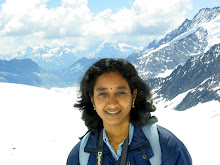Yakshagana

Yakshagana is a folk form that originated in Kanara -- the coastal strip of Karnataka. The earliest reference to this dance form is in "Bharatatesha Vaibha" (written in 1557) which confirms that the folk form is at least 450 years old. It has its base in the ritualistic Nagamandala practices. The heart of this form is Gana (song), arising from a distinct class of Kannada literature. Particularly every theme carries a moral.

A play generally has 200 to 300 stanzas set to various meters. The "Bhagvata" or the conductor of the dance-opera first sings a verse and the characters interpret it through expressional dance. About 150 ragas are known to the Yakshagana tradition. The principal manifestations are of Vishnu. The dance is usually performed when the crop has been harvested.

Footwork in this dance form is very important, though hasta or hand gestures are almost absent. Aharya or make-up is distinctive as in Kathakali. The characters are divided into certain principal types. Noble kings have a large black moustache and a sacred red mark on the forehead. A guilded crown adds appeal to kings and heroes. The central character in the above picture is "Mahishasura Mardhini".

Trivia
Kuchipudi, originally from Andhra Pradesh, is one of the classical dances of India. It’s evolution can be traced to traditional dance - drama, known under the generic name of Yakshagaana. In 17th century A.D. Siddhendra Yogi, a talented Vaishnava poet, conceived Kuchipudi style of Yakshagaana. It begins with an invocation to Lord Ganesha followed by nritta (non-narrative and abstract dancing); shabdam (narrative dancing) and natya.

Labels: Folk Dance, Karnataka


0 Comments:
Post a Comment
Subscribe to Post Comments [Atom]
<< Home